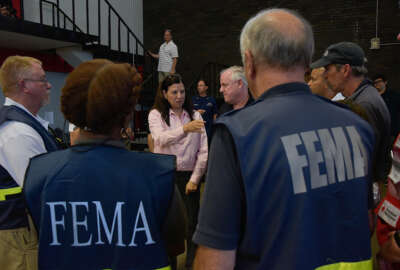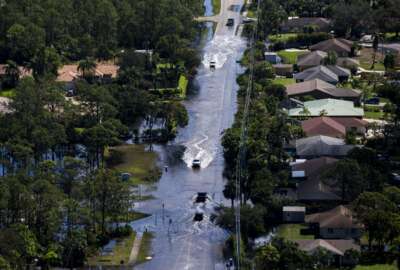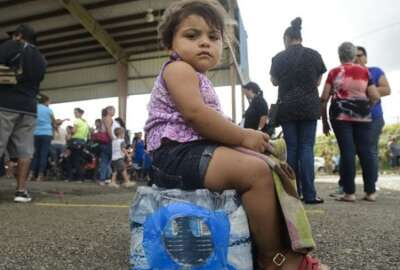
FEMA ‘ready and poised’ to activate Surge Capacity Force if necessary
The Federal Emergency Management Agency is taking Hurricane Florence seriously, and it’s not ruling out any options in responding. That includes activating the...
Best listening experience is on Chrome, Firefox or Safari. Subscribe to Federal Drive’s daily audio interviews on Apple Podcasts or PodcastOne.
The Federal Emergency Management Agency is taking Hurricane Florence seriously, and it’s not ruling out any options in responding. That includes activating the Surge Capacity Force, a volunteer corps of federal employees from across government that would deploy to support FEMA’s response.
“That was a definite success that we utilized in 2017,” Jeff Byard, assistant administrator for Response and Recovery at FEMA, said during a Sept. 11 press briefing. “What we’re looking at now is more of a surgical activation if that comes about, of the right people doing the right job at the right time. But yes, we definitely looked at that, and are currently looking at that. We’ve got great partnerships within the department, obviously. The secretary was here today, and if that’s a necessary resource, we’re ready and poised to activate that.”
Acting DHS Secretary Elaine Duke expanded the Surge Capacity Force last September to include federal employees from all cabinet agencies. Previously, the SCF only included non-FEMA, DHS employees.
Roughly 2,740 employees from eight DHS components and 1,323 employees from 34 non-DHS agencies joined the Surge Capacity Force to respond to Hurricanes Harvey, Irma and Maria, according to FEMA’s report.
In total, 4,063 non-FEMA federal employees, more than three times the amount the agency surged for Hurricane Sandy, deployed to hurricane impacted areas.
But FEMA is determined not to make the same mistakes it did in 2017. And one of those issues, according to its after-action report, was staffing.
“We do have the staff that we need to embed with the states,” Byard said. “Our emergency management professionals are out there. … One of the lessons that we are doing different this year is we are deploying the right staff at the right time to meet the needs, so you may see a smaller footprint from the operations staff, but again, that’s what’s needed at that time in the states. We’re going to push heavy on our disaster survival assistance teams. Those are the teams that get out into the affected areas when it’s safe to do so to start working with the states and survivors.”
In looking back on its response to 2017’s disasters, FEMA said its workforce was well understaffed, under-trained and ill-prepared to respond at the start of last year’s hurricane season.
From Aug. 25 through Nov. 30 last year, 73 percent of FEMA’s response workforce was deployed to disaster-affected areas, the agency said. More than half of FEMA’s specialized response and recovery cadres were staffed at 25 percent or lower for 45 days or more.
Much of the staff FEMA did have were under-certified, according to the agency. FEMA expects about 80 percent of its workforce to be certified in disaster response and recovery, but the staff the agency deployed to last year’s disaster areas fell well below that target.
“Our priority will always be lifesaving,” Byard said. “Our effort is going to be on stabilization of those critical lifelines.”
The critical lifelines Byard referred to include safety and security, health and medical, food and water, transportation, communication, power and hazardous materials.
Much of the efforts in these areas will involve coordination and support, as FEMA pursues what Byard called a “whole of community approach.” Toward that end, Byard said FEMA activated its National Response Coordination Center that morning, representatives from its federal partners were present, communications are ongoing with other stakeholders, and field leaders are embedded with state and local governments.
“We are positioned to support our state and local governments as they prepare for the response to Hurricane Florence,” he said. “Government is just one form of assistance, and one form of resources. We are partnered with NGO partners such as the Red Cross and others. We are partnered with the private sector. That is a major lesson learned coming out of 2017. We will be enablers to what they bring to the table, and how we can support the efforts of stabilization of our critical lifelines.”
For example, FEMA is partnering with private transportation companies to help pre-position food and water supplies for the affected areas, and that’s just a small piece of the whole emergency feeding mission. State and local governments, as well as NGOs like the Red Cross also have supplies at the ready, and will assist in distribution both during the storm and the recovery period.
FEMA is also coordinating with medical facilities like hospitals to plan for potential evacuations, because FEMA is counting on losing power en masse. That’s why it’s currently activating mutual aid contracts with power companies, Byard said.
“This is not a storm that on day three the roads will be back … and power will be back on,” Byard said. “That is not what we’re facing with that storm.”
Copyright © 2025 Federal News Network. All rights reserved. This website is not intended for users located within the European Economic Area.
Daisy Thornton is Federal News Network’s digital managing editor. In addition to her editing responsibilities, she covers federal management, workforce and technology issues. She is also the commentary editor; email her your letters to the editor and pitches for contributed bylines.
Follow @dthorntonWFED
Related Stories





